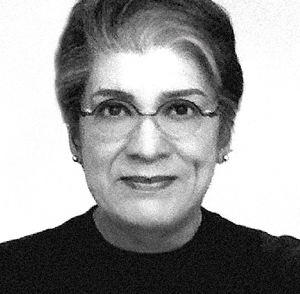
Chicana feminism is a sociopolitical movement, theory, and praxis that scrutinizes the historical, cultural, spiritual, educational, and economic intersections impacting Chicanas and the Chicana/o community in the United States. Chicana feminism empowers women to challenge institutionalized social norms and regards anyone a feminist who fights for the end of women's oppression in the community.

Yolanda Margarita López was an American painter, printmaker, educator, and film producer. She was known for her Chicana feminist works focusing on the experiences of Mexican-American women, often challenging the ethnic stereotypes associated with them. Lopez was recognized for her series of paintings which re-imagined the image of the Virgen de Guadalupe. Her work is held in several public collections including the Smithsonian American Art Museum, the San Francisco Museum of Modern Art, and the Los Angeles County Museum of Art.
The UCLA Chicano Studies Research Center (CSRC) was founded in 1969 to foster multidisciplinary research efforts at the University of California, Los Angeles (UCLA). It is one of four ethnic studies centers established at UCLA that year, all of which were the first in the nation and have advanced our understanding of the essential contributions of people of color to U.S. history, thought, and culture. The centers remain the major organized research units in the University of California system that focus on ethnic and racial communities and contribute to the system's research mission.
Alicia Gaspar de Alba is an American scholar, cultural critic, novelist, and poet whose works include historical novels and scholarly studies on Chicana/o art, culture and sexuality.

Alma López is a Mexican-born Queer Chicana artist. Her art often portrays historical and cultural Mexican figures, such as the Virgin of Guadalupe and La Llorona, filtered through a radical Chicana feminist lesbian lens. Her art work is meant to empower women and indigenous Mexicans by the reappropriation of symbols of Mexica history when women played a more prominent role. The medium of digital art allows her to mix different elements from Catholicism and juxtapose it to indigenous art, women, and issues such as rape, gender violence, sexual marginalization and racism. This juxtaposition allows her to explore the representation of women and indigenous Mexicans and their histories that have been lost or fragmented since colonization. Her work is often seen as controversial. Currently, she is a lecturer at the University of California Los Angeles in the Department of Chicana/o Studies.

Judithe Hernández is an American artist and educator, she is known as a muralist, pastel artist, and painter. She a pioneer of the Chicano art movement and a former member of the art collective Los Four. She is based in Los Angeles, California and previously lived in Chicago.

The Chicano Art Movement represents groundbreaking movements by Mexican-American artists to establish a unique artistic identity in the United States. Much of the art and the artists creating Chicano Art were heavily influenced by Chicano Movement which began in the 1960s.
Willie Herrón III is an American Chicano muralist, performance artist and commercial artist.
Asco was an East Los Angeles based Chicano artist collective, active from 1972 to 1987. Asco adopted its name as a collective in 1973, making a direct reference to the word's significance in Spanish ("asco"), which is disgust or repulsion. Asco's work throughout 1970s and 1980s responded specifically to socioeconomic and political problems surrounding the Chicano community in the United States, as well the Vietnam War. Harry Gamboa Jr., Glugio "Gronk" Nicandro, Willie Herrón and Patssi Valdez form the core members of the group.
Laura Aguilar was an American photographer. She was born with auditory dyslexia and attributed her start in photography to her brother, who showed her how to develop in dark rooms. She was mostly self-taught, although she took some photography courses at East Los Angeles College, where her second solo exhibition, Laura Aguilar: Show and Tell, was held. She was well-known for her portraits, mostly of herself, and also focused upon people in marginalized communities, including LGBT and Latino subjects, self-love, and social stigma of obesity.
Cesar Garcia is a Mexican-born American scholar, writer, curator, and educator. He is the founder and current director and chief curator of The Mistake Room, in Los Angeles.
Yreina Cervantez is an American artist and Chicana activist who is known for her multimedia painting, murals, and printmaking. She has exhibited nationally and internationally, and her work is in the permanent collections of the Smithsonian American Art Museum, The Mexican Museum, the Los Angeles County Museum, and the Los Angeles Museum of Contemporary Art.
Hijas de Cuauhtémoc was a student Chicana feminist newspaper founded in 1971 by Anna Nieto-Gómez and Adelaida Castillo while both were students at California State University, Long Beach.
Rita Gonzalez is an American curator, author and media artist. She is the head of the contemporary art department at Los Angeles County Museum of Art (LACMA), an institution she has worked at since 2004. Many of her curatorial projects involve under-recognized Latinx and Latin American artists.
Dolores Guerrero-Cruz is an American artist, she is known for her contemporary art through paintings, murals, and graphic art. Her art reflects her advocacy towards the feminist movement and empowerment movement for the Chicano and Latin community.
A Mexican American is a resident of the United States who is of Mexican descent. Mexican American-related topics include the following:
Chon A. Noriega is an American art historian, media scholar, and curator. Noriega is professor of cinema and media studies at UCLA School of Theater, Film and Television. He was also the director of the UCLA Chicano Studies Research Center (CSRC) from 2002 to 2021.
Margaret Garcia is a Chicana muralist, educator, and arts-advocate based in Los Angeles.
Lucila Villaseñor Grijalva is a Chicana muralist who was born in Los Angeles, California. Her art style is inspired by graffiti art.
Angélica Becerra is an activist visual artist who primarily works in watercolor and digital media.




